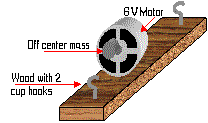Ripple tank
A ripple tank is a shallow glass tank of water used in schools and colleges to demonstrate the basic properties of waves. The tank is illuminated from above, so that the light shines through the water. The ripples on the water show up as shadows on the screen underneath the tank.

A piece of wood is suspended above the tank on elastic bands so that it is just touching the surface. Screwed to wood is a motor that has an off centre weight attached to the axle. As the axle rotates the motor wobbles.
Properties of waves that can be demonstrated with a ripple tank:

The ripple motor is connected to a variable 6V DC supply. The rippler is lowered so that it just touches the surface of the water and the motor is turned on. Plane waves will move towards the left.

By placing a metal bar in the tank and tapping the wooden bar a pulse of three of four ripples can be sent towards the metal bar. The ripples reflect from the bar. If the bar is placed at an angle to the wavefront the reflected waves can be seen to obey the law of reflection. The angle of incidence and angle of reflection will be the same.
If a concave semicircular obstacle is used, a plane wave pulse will converge on a point after reflection. This point is the focal point of the mirror. Circular waves can be produced by dropping a single drop of water into the ripple tank. If this is done at the focal point of the "mirror" plane waves will be reflected back.
If a sheet of glass is placed in the tank the depth of water in the tank will be shallower over the glass than elsewhere. The speed of a wave in water depends on the depth, so the ripples slow down as they pass over the glass. This causes the wavelength to decrease. If the junction between the deep and shallow water is at an angle to the wavefront the waves will refract.
If a small obstacle is placed in the path of the ripples there is no shadow area as the ripples refract around it. If a large obstacle is placed in the tank a shadow area will be observed.
If an obstacle with a small gap is placed in the tank the ripples emerge in an almost semicircular pattern.
Small in this context means comparable to the wavelength of the ripples.
Lots more info to follow. I'm working on several diagrams
